



The Possibilities of Digital and Analogue Technology in Parkinson’s Julio Vega
Symptom Knowledge in Parkinson’s (digital) 2
Previous work Most approaches have been ● Uncomfortable ● Disruptive ● Motor oriented ● Using a single device @julio_ui 3
Missing potential Consumer electronics can be heterogeneous (mixed) data sources Personal Environmental Web Movement Infrared Weather Smartphones Pressure Social Networks Wearables Video Geographic data @julio_ui 4
What is new in SKIP? Combine heterogeneous sources to allow an assessment that is: Continuous ● Longitudinal ● Naturalistic ● Unobtrusive ● Personalised ● @julio_ui 5
Our goal is to reconstruct people’s daily routines 6
Methodology Heterogeneous Profile of Digital transform transform data Living Biomarkers @julio_ui 7
Profile of Living @julio_ui 8
Digital Biomarkers Examples 9
Visited places day 01 - 15 day 16 - 30 @julio_ui 10
Phone usage 00:00 - 12:00 - 23:59 - July ‘17 October ‘17 January ‘18 @julio_ui 11
Current work We are running a 9-month study ● Monitoring 11 people, 24/7 ● Collecting up to 22 different data sources using Android and iOS smartphones as main device ● Visiting participants every six weeks to collect ground truth @julio_ui 12
And Analogue... 13
Agile Prototyping 1 2 3 4 5 @julio_ui 14
Paper Diary 6 Flexible ● Personalised ● No handwriting required ● Blending digital/analogue ● Open source ● 97% compliance ● @julio_ui 15
Design implications 1. Reduce participant completion demand 2. Design to offset the effect of tremor on input 3. Enable implicit reminders 4. Design for consequences of increased awareness 5. Consider the effects of handwritten notes in compliance, encoding burden and data quality Published in CHI’18: bit.do/paper_diary @julio_ui 16
PaperStream You can use PaperStream to create and encode diaries/surveys for free bit.do/pstream @julio_ui 17
Key messages Design for and Design for and Consider analogue Aim for unobtrusive and with People with with People with approaches personalised Parkinson’s Parkinson’s @julio_ui 18
Thank you! julio.vega@manchester.ac.uk @julio_ui juliovega.info 19
First efforts Interviews with clinicians and ● neuroscientists Focus groups with people with ● Parkinson’s Pilot study monitoring 2 people, 24/7 for ● 3 months using a smartphone @julio_ui 20
Call log 00:00 - 12:00 - 23:59 - July ‘17 October ‘17 January ‘18 @julio_ui 21
Evaluation Predict clinical scores based on fluctuation scores @julio_ui 22
Bluetooth profiling bluetooth devices bluetooth devices bluetooth devices 01 02 03 04 05 06 07 08 09 10 21 22 23 24 25 26 27 28 29 30 11 12 13 14 15 16 17 18 19 20 days days days @julio_ui 23
Problem 1. Parkinson’s is neuro-degenerative and incurable 2. Symptoms are many and fluctuate daily 3. Patients visit their clinicians twice a year Emotional Motor Cognitive @julio_ui 24
Goals Is it possible to: 1. Infer complex human behaviour from heterogeneous data? 2. Measure the influence of Parkinson's on the inferred behaviour? 3. Monitor Parkinson’s progression using the fluctuations of such behaviour? @julio_ui 25
Metrics to explore Digital Biomarker Metric 1. Time at home 2. Visited places (frequency, duration) Social Interaction 3. Duration & frequency of calls and texts 4. Profiling of Bluetooth devices 1. Get-up time 2. Bed time Phone use 3. Typing patterns 4. Use sessions at day and night @julio_ui 26
Recommend
More recommend